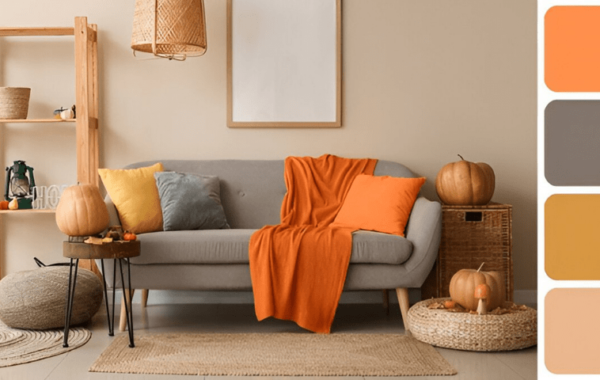
The Psychology of Color in Interior Design: A Comprehensive Guide
Have you ever wondered how your mood instantly changes when entering a colorful room? Colors have the magical power of healing and energizing people’s minds. Besides, it communicates with your feelings and helps lower or raise your emotions. Every color has unique features, which will do its best for its needs. It is proven that the paint we use every day has an impact on our lives. Hence, it is high time to know the perfect room color design selection for your home interiors.
What is the psychology of Color?
The psychology of colors is nothing but its impact on human behavior and productivity. The different colors can change our emotions in different ways in the space we inhabit. Other colors can evoke different feelings or emotions.
Emotion of Colors:
Understanding the emotions associated with different colors can help us make informed choices for room color design in various aspects of home interiors, from fashion to interior design and even branding.
Red is a vibrant and attention-grabbing color. It’s often associated with strong emotions like passion, love, and anger. This dynamic color can increase heart rate and create a sense of urgency, making it an excellent choice for conveying excitement and intensity. Red is frequently used when we want to provoke action, such as in advertising and warnings.
Blue is known for its calming and soothing effect. It’s often associated with trust, stability, and serenity. Blue can reduce stress and anxiety, so it’s commonly used in bedrooms and offices. Lighter shades of blue evoke feelings of tranquility, while darker blues can convey a sense of professionalism and reliability.
Warm and upbeat, yellow is a color that brings happiness, energy, and optimism to mind. It’s often used to create a welcoming atmosphere, so you see it in kitchens and dining rooms. However, too much yellow can be overwhelming, so using it in moderation is essential.
Green is the color of nature and balance. It’s associated with growth, health, and renewal. The calming and restorative qualities of green make it a fantastic option for places like bedrooms and living rooms where relaxation and well-being are essential.
Purple is a rich and luxurious color often linked to creativity and imagination. Paler variations of purple, like lavender, can be calming, while deeper purples exude a sense of opulence and regality. It’s a popular choice for creative spaces and products that aim to communicate a sense of sophistication.
Orange is an energetic and enthusiastic color associated with excitement, creativity, and fun. It’s a warm color that can add a burst of energy to a space. Orange is often seen in playful environments and elements that aim to create a lively atmosphere.
Pink is a soft, gentle color associated with love, compassion, and tenderness. This color has the power to arouse emotions of nurturing and sweetness. Pink is often used in spaces designed for relaxation and tranquility, such as bedrooms and nurseries.
Brown is a stable, earthy color associated with reliability, security, and warmth. It’s commonly used in interior design to create a sense of comfort and a connection to the natural world. Brown can evoke feelings of stability and dependability.
Black is a color often linked to sophistication, elegance, and power. It’s also associated with mystery and the unknown. In fashion, black is a classic choice for formal occasions, conveying a timeless style. However, too much black can create a sense of heaviness and darkness.
White is often associated with purity, simplicity, and cleanliness. It’s a versatile color that can create a sense of openness and space. In interior design, white makes rooms feel more extensive and more airy. It’s also a popular choice for conveying a sense of cleanliness and hygiene.
Gray is a neutral color that’s often linked to balance and neutrality. It’s a versatile color that conveys refinement and elegance. Lighter shades of gray evoke calm and simplicity, while darker grays give a sense of seriousness and formality.
Emotion of Colors:

The Emotional Impact of Color Combinations
In addition to the emotions associated with each color, how colors are combined can also significantly impact our feelings.Here are a few examples of color combinations and their emotional effects for your room color design:
1.Complementary Colors:
Like red and green, colors opposed to one another on the color wheel produce an eye-catching visual contrast, this combination can evoke excitement and energy.
2.Analogous Colors:
Harmonious and soothing effects are produced by colors close to one another on the color wheel, such as blue, green, and blue-green. This combination is often used to develop a sense of balance and unity.
3.Monochromatic Colors:
Variations of a single color, such as shades of blue, are used in monochromatic color schemes.This method can arouse feelings of serenity and simplicity while producing a unified and refined appearance.
4.Triadic Colors:
Triadic color combinations use three hues, red, yellow, and blue, that are equally distanced from one another on the color wheel.This approach creates a dynamic and vibrant effect, often used in designs that aim to be visually stimulating.
Using Color Psychology in Interior Design
Interior Design is not just about arranging furniture and decor; it’s also about creating a mood and atmosphere for your room color design within a space. Color is crucial in achieving this, as it profoundly impacts our emotions and well-being. By incorporating principles of color psychology into your interior design, you can create aesthetically pleasing spaces and evoke the desired emotional response.
Here are some practical tips for using color psychology in interior design for your room color design:
1.Understand the Basics of Color Psychology:
To effectively use color psychology in interior design, start by familiarizing yourself with the primary emotional associations of colors, as mentioned in the previous section. For example, red evokes passion and excitement, while blue is associated with calm and trust. These associations will guide your color choices.
2.Consider the Function of the Space:
The first step in choosing colors for a room is to consider its purpose. Different colors are suitable for other functions.For example:
Typically, you want a living room to be inviting and comfortable. Warm, neutral colors like soft beige or warm gray can create a cozy atmosphere. You can then integrate pops of color through accessories.
A bedroom should be a tranquil space. Cool colors like soft blues or pale greens promote r laxation. You can also use pastels for a soothing effect.
Warm colors like orange or red are frequently used in kitchens because they stimulate vitality and appetite. However, use these colors sparingly, as they can become overwhelming. Balance them with neutral tones.
For a productive home office, choose colors that boost focus and creativity. Blues and greens are good choices for maintaining concentration. You can incorporate small touches of brighter, motivating colors.
Consider serene colors like light blues and soft greens to create a spa-like retreat. These colors are often associated with cleanliness and relaxation.
3.Balance and Contrast:
It’s essential to balance bold and neutral colors in a room. While bold colors can make a statement, they should be balanced with more subdued hues to avoid overwhelming the space. For instance, if you have a bold red wall, balance it with neutral-colored furniture and accessories.
4.Consider Natural Light and Artificial Lighting:
Lighting can significantly affect how colors are perceived in a space.Natural light can make colors appear more vivid and accurate,while artificial lighting can alter how we see colors.Always test paint colors in the actual lighting conditions of the room to see how they look.
5.Personalize Your Space:
Remember to add personal touches to your design. Incorporate colors that resonate with you and reflect your personality and interests. These personalized elements can make your home feel unique and comfortable.
6.Transitional Spaces:
When designing transitional spaces like hallways or corridors,designers use colors that complement the colors of the rooms they connect.This creates a sense of cohesion and harmony as you move from one room to another.
7.Experiment and Update:
Interior design is dynamic, and you can experiment with color schemes. Be bold and update the colors in your home as your preferences and needs change over time.
8.Consider the Cultural and Personal Factors:
Keep in mind that cultural and personal factors can influence color perception. What might be calming in one culture could be energizing in another. Consider the preferences and experiences of the people using the space.
9.Test Samples:
Before committing to an entire room, testing paint colors on a small wall area is always a good idea. This allows you to see how the color works in the specific lighting conditions of the room.
By integrating color psychology into your interior design, you can create spaces that look beautiful and feel right. Color choices can impact a room’s mood, atmosphere, and functionality, making it a valuable tool in achieving your design goals. Whether you’re creating a peaceful retreat or an energizing workspace, the colors you choose can profoundly affect the overall experience of your living spaces.
Cibi+Simeon Designs is the leading interior and architecture company in Chennai. We work on house interiors, office interiors, and so on, which will achieve a pleasing and relaxing effect. We specialize in designing aesthetic house interiors using colors that enhance the quality of our clients’ lives. Hire us for quality living.


